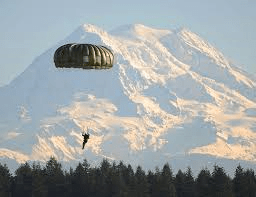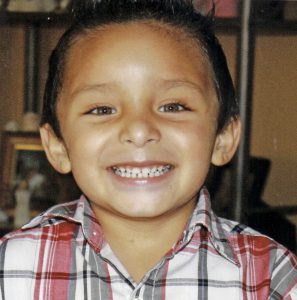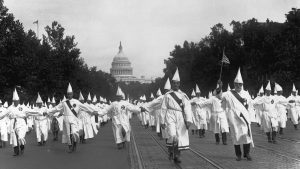Winner of theSpring 2018 StMU History Media Award for
Best Article in the Category of “Social History”
What is courage? What is strength? Perhaps it is being ready to fight for your nation even when your nation isn’t ready to fight for you.1 Imagine jumping out of a plane for the sole purpose of protecting that same nation. That is exactly what the 555th Infantry, the first all African-American unit, did during World War II. They stood in the doorway of the plane with a hundred pounds of gear strapped to their backs and await the jumpmaster’s commands.2 They hear “load” and “follow the trooper in front to your spot” and “wait.” As your turn approached, you looked down and saw the world below you as the wind ripped around your face. The men in the 555th battalion stood out among the rest of those troopers because they had to fight to be able to stand on the edge of that plane’s doorway and stare down fear in the face. They did this for the sake of a nation that segregated and mistreated them.

During World War II, paratroopers would leap from planes and parachute behind enemy lines to gather intelligence or fight from the inside of a battle and work their way out. Many, including the US military, believed that to be a paratrooper one needed specialized training, extreme physical fitness, courage, and, up until the Triple Nickles, white skin.3 The 555th Parachute Infantry Battalion was not legitimately formed until December 31, 1943. Before officially becoming a unit, many of the African-American soldiers did menial things like cooking and cleaning.4 Enlisted African Americans were segregated from white soldiers and regularly assigned to those kinds of duties. While thousands of American soldiers were fighting the Axis powers, African-American soldiers were fighting discrimination to be able to fight alongside those overseas. However, at Fort Benning, Georgia, one enlisted African American, Walter Morris, decided he wanted to change that. Morris and his company were assigned the task of cleaning up the training areas where the white paratroopers prepared for parachute duty. Morris saw the struggles and low morale of his company, so he decided to give them a goal to strive towards. Each night after all the other infantry parachute units finished training, Morris and his men would run through the same course that they saw performed earlier that day. This course included 34-foot towers, mock aircrafts, and pull-up bars.5 They secretly went behind the backs of authority figures just to feel a new sense of purpose. Not long after this, Morris saw his men transform into soldiers. However, that all came to a crashing halt when the company’s secret training sessions came to the attention of the commanding General Ridgely Gaither as he drove past the training field one night. The next day Morris was called to his office while the rest of the battalion awaited their fate.
Morris walked into the office and explained what he and his men had been up to and accepted full responsibility for their actions. However, in an unexpected turn of events, the general said, “I’m going to tell you something you don’t know, Walter Morris,” and proceeded to praise him and his men for taking initiative.6 The general officially assigned Morris as the first sergeant of the newly created 555th Parachute Infantry Unit as a test platoon. As Morris left, he said, “My head was in the clouds… My heart almost bust right there.”7
The 555th Infantry, also affectionately nicknamed the Triple Nickels, began training in January 1944. The men knew that they had a difficult challenge ahead of them, because they had to be better than any other unit to be considered equivalent. There were different stages of training that they had to undergo to be able to graduate. Stage A consisted of extreme physical fitness from daylight to dark, with classes on equipment and orders in between. In Stage B they began using equipment to complete obstacles on a much higher level. One of these training sessions included the Trainasium, which was a large obstacle course in the air that was used for agility exercises, and which would test a trainee’s ability to carry out simple instructions and activities above ground level as well as help the trainee conquer any fears of heights he might have.8 Therefore, the paratroopers worked and trained twice as hard as the white paratrooper units.9 Soon, the 555th became one of the best trained battalions in the army. When graduation arrived on February 8, 1944, seventeen paratroopers received their wings. Morris was the first African-American paratrooper to parachute out of a plane. They were the very first all African-American paratroop infantry, while also taking a step in the direction of ending segregation in the military. They were pushing the government towards racial justice and beating the odds of being an African-American paratrooper. Not long after they graduated, they became more well-known, and other African Americans began to enlist to be a part of the company. So many men joined up that the company grew into a battalion. The Triple Nickels patiently waited to be assigned to go join the fight in Europe, but the assignment they received was not what they had expected. The battalion was assigned to a 300-man smokejumper firefighting component in Camp Pendleton, Oregon.10

The Japanese had created a type of incendiary bomb that Americans commonly called balloon bombs. Japanese Lieutenant-General Reikichi Tada led a program that designed a four-meter balloon capable of delivering explosives up to seventy miles.11 After nearly a year of research and testing, his team came up with a design capable of remaining aloft for thirty hours at an altitude of 25,000 feet for over hundreds of miles.12 The Japanese would launch the balloons from submarines, which would release a 5-kilogram bomb once it touched down. The bombs were intended to land in forests and cause massive forest fires, which would put the lives of Americans at risk. The American navy would not send out aircraft or ships to stop these submarines because they did not see it as a large threat. The Japanese kept modifying and perfecting their balloons to the point that they could fly all the way from Japan to America. At one point, America had approximately ten thousand balloon landings. They needed someone to be able to get in and disarm them quietly. The Triple Nickles were disappointed in their new highly classified mission, but were pleased that they had been assigned a task to help America in the war.
These bombs were initially discovered by a young preacher, his wife, and five teenagers. They stopped because they had found a truck stuck in the mud. They all got out and were heading over to offer some help. However, his wife and the five children spotted a large balloon not far from where they were standing. Before the young pastor could tell them not to touch it, a large blast exploded from within the balloon. All six innocent Americans died in the explosion and the army and forest service then started discovering more of these balloon bombs. Shortly after, the army began Operation Firefly. Although the Triple Nickles did not get to go overseas, they began to see the importance of their mission and the contribution they would make, even if no one was watching.

This 555th Infantry Battalion was assigned to the Forest Fire Service as part of Operation Firefly.13 Operation Firefly was tasked to prevent forest fires, halt forest fires, or prevent an explosion if the balloon bombs were still armed. The Forest Service was having a hard time battling the fires because they could not get men into the forest fast enough to stop the fires while they were still small. The men took part in training to learn how to parachute down into rugged terrain and set up a fire line to stop the fires. The battalion also went through demolition training so that they could disable unexploded bombs. They were given fifty-foot ropes in case they got stuck in trees, and a parachute. The men started wearing old football helmets with chicken wire as face masks to protect them from branches and rough landings. The unit would stay in the fire zones and forests for days at a time, and when they extinguished a fire, they would then hike back to base miles away. The military and Forest Services kept the missions of the Firefly operation secret. They did not want Americans to know that America was under attack on its own soil, and they did not want the Japanese to know that their small-scale attacks were successful. The 555th Parachute Battalion became the first and only “smoke jumpers.”14
In the spring of 2010 the Pentagon paid tribute to the Triple Nickels for being the US Army’s first all-black paratrooper unit and for their contributions to the safety of America.15 By the end of the war, the 555th parachute infantry battalion logged more than 1,200 smoke-jumping missions. The 555th infantry smokejumpers’ assistance in Operation Firefly helped save American lives. But it also helped to keep the hopes of Americans positive during the war by keeping the balloon bombs a secret. They succeeded where they were not expected to succeed and overcame pitfalls that were put there. It had nothing to do with the color of their skin. It had to do with the bravery that each one of those men had inside of them.
- Tonya Lee Stone, Courage has no color: The story of the Triple Nickles: America’s first Black paratroopers (Somerville, Mass.: Candlewick Press, 2013), 3. ↵
- Tonya Lee Stone, Courage has no color: The story of the Triple Nickles: America’s first Black paratroopers (Somerville, Mass.: Candlewick Press, 2013), 5. ↵
- Tonya Lee Stone, Courage has no color: The story of the Triple Nickles: America’s first Black paratroopers (Somerville, Mass.: Candlewick Press, 2013), 9. ↵
- Jacqueline M. Hames, “Jumping into History: The Army’s First African American Paratroopers,” Soldiers 2, (2014): 1. ↵
- Robert F. Dorr, “555th Parachute Infantry confronted challenges, bigotry,” Army Times 61, no. 30: 41 (2001): 2. ↵
- Jacqueline M. Hames, “Jumping into History: The Army’s First African American Paratroopers,” Soldiers 2, (2014): 1. ↵
- Tonya Lee Stone, Courage has no color: The story of the Triple Nickles: America’s first Black paratroopers (Somerville, Mass.: Candlewick Press, 2013), 23. ↵
- Tonya Lee Stone, Courage has no color: The story of the Triple Nickles: America’s first Black paratroopers (Somerville, Mass.: Candlewick Press, 2013), 32. ↵
- Jacqueline M. Hames, “Jumping into History: The Army’s First African American Paratroopers,” Soldiers 2, (2014): 1. ↵
- Jacqueline M. Hames, “Jumping into History: The Army’s First African American Paratroopers,” Soldiers 2, (2014): 2. ↵
- Ross Allen Coen, Fu-go: The Curious History of Japan’s Balloon Bomb Attack on America (Lincoln, NB,: University of Nebraska Press, 2014), 17. ↵
- Ross Allen Coen, Fu-go: The Curious History of Japan’s Balloon Bomb Attack on America (Lincoln, NB,: University of Nebraska Press, 2014), 17. ↵
- Jacqueline M. Hames, “Jumping into History: The Army’s First African American Paratroopers,” Soldiers 2, (2014): 2. ↵
- Ross Allen Coen, Fu-go: The Curious History of Japan’s Balloon Bomb Attack on America (Lincoln, NB,: University of Nebraska Press, 2014), 32. ↵
- Brendan Manley, “‘Triple Nickle’ para jumpers honored,” Military History 10, (2010): 14. ↵



90 comments
Maisie Favila
Parachuting has always been an interest of mine, but I am too scared so reading about people actually doing it out of courageousness is amazing. The opener with the questions for this article was very good and kept me hooked. These people truly put others lives ahead of their own at this time. The amount of dedication they had as described throughout the article leaves me in aw. Overall, this article was very well written and informative.
Bictor Martinez
I am happy to hear that these soldiers got the recognition they deserved. They were able to successfully disarm the bombs to save American lives. It is also unfortunate that the white soldiers thought different of the African American soldiers just because of their skin color, but despite that the African American soldiers continued their mission. Just as the article states that it is not a matter of their skin however, it had to do with the bravery each men had inside of them. Great article.
Luke Lopez
This was a very interesting article on the 555th infantry. I had never heard of this infantry before, but I now know that the 555th saved American lives, such as in Operation Firefly. Operation Firefly sought to prevent forest fires from occurring. Overall, this was a great article on the 555th infantry and how this infantry valiantly fought for their country.
Jasmine Rocha
The article was very well written and very informative on the determination of the 555th’s. Their willingness to protect a nation that at the time treated African Americans poorly not only because it was their home but also to be heroes to future generations. The job these men had was important even though they weren’t actually going to fight but helped prevent casualties by disarming bombs. They should truly be highlighted and be important because every soldier role for their country is important either big or small.
Honoka Sasahara
It was so interesting and sophisticated article! I have never heard the story about balloon bombs attack by Japan to U.S. before. Although the work of the 555th Infantry was not known to American citizens, their contribution to the nation must have been immense. It is wonderful that the African Americans were devoted to their country despite the treatment they got.
Christopher Vasquez
The 555th’s determination was second to none. It amazes me to know that they were willing to protect a nation that treated African Americans so poorly; these men were true heroes. I related to this story more than I thought because my uncle, when he was serving, also was a parachute. It must have been beyond terrifying to be in the airplane, looking down to see how far up one is in the plane. Also, these men helped prevent massive casualties on American soil by disarming the Japanese balloon bombs. Above all, their bravery and readiness to protect a racist America are inspiring. Because of these heroes, the rest of America was beginning to realize that racism of any kind is always wrong.
Robert Freise
The treatment of African Americans was just awful during this time, they had to band together due to racism and constant harassment. The fact that many Africans had to fight for a country that neglected them and consistently oppressed them is the one of the hardest things that I could imagine. I’m sure that many soldiers made racist remarks to the 555th Parachute Infantry, These men were dying for your country and people couldn’t comprehend and their narrow mind made it hard for many of these soldiers to fight for something. They fought for their families and friends back in their communities.
William Rittenhouse
The 555 had to be pretty disappointed when they realized they weren’t actually going to fight. As soon as they started their missions the importance probably grew on them. They were involved in the defense of Americas mainland. While Pearl Harbor was also carried out by the Japanese, it did not affect the mainland. It was a smart move to keep quiet about these to keep the morals of Americans high.
Jabnel Ibarra
The bravery and dedication of the 555th battalion is incredibly admirable. To not only stand up in the face of discrimination but also prove themselves as soldiers is amazing and inspiring. Though their work was not under a spotlight and for the most part largely unknown, they remained dedicated and continued to fight from their country, regardless of whether or not they would receive recognition for it.
Tyler Boyd
This was an amazing story that I had never heard before. I can’t believe that these men had over 1,200 jumps during the war. That is an absolutely insane number far larger than that of there peers. I believe that these men were truly American heroes who sacrificed and worked far harder than their peers. Congratulations on the nomination and thank you for telling this amazing story!